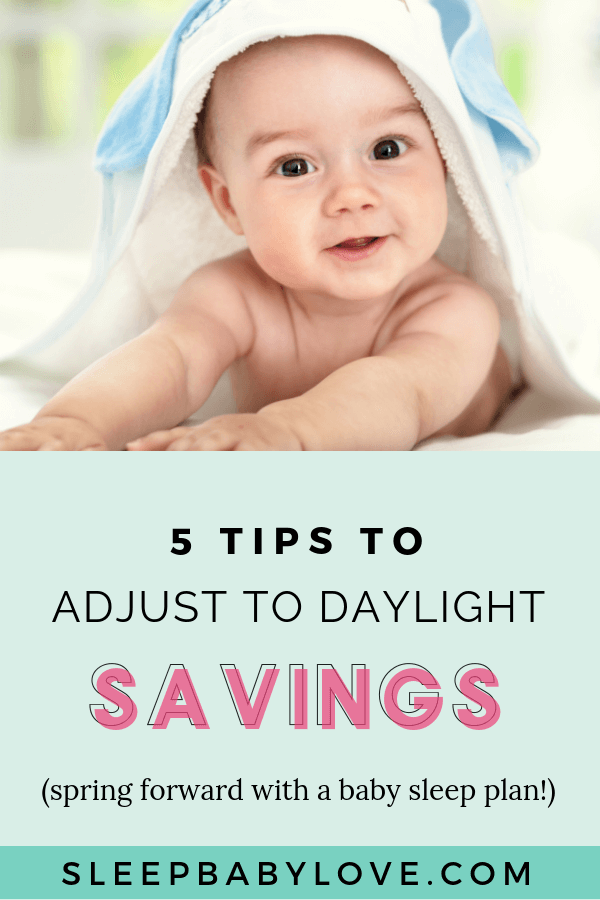Spring Forward: 5 Tips to Adjust to Daylight Saving Time
If you’ve been following Sleep Baby Love for a while, you will know two things 1) you will get awesome sleep tips for both babies and toddlers 2) twice a year, you will get an article about how to adjust to daylight saving time.
So here we are yet again! Who’s ready to spring forward? (and while you’re thinking about that question, I really wonder why I didn’t yet move to Arizona, where they don’t live to deal with this!)
Daylight Savings Time Starts on Sunday, March 14th at 2 am. We will move our clocks forward one hour.
What does it mean to Spring Forward?
On Sunday, March 13th – 6am is now 7am – and 6pm is really 7pm.
In my opinion, this is the better of the two daylight saving time adjustments (especially when you have kids) – since your early risers will actually wake up at a normal time (even if it’s just because of some clock magic and even if it only lasts a day or two).
This is the time of year when it will remain darker in the morning and stays light at night, too since in a month or two; you will start to see the sunrise earlier in the morning (and that is a whole different story how sleep gets messed up).
Oh, and after the time change, even though your child may wake up a little later (by the clock), they might not be too excited to go to sleep an hour earlier if you try to adjust right away…
Here are the best tips to prepare for the adjustment to daylight saving time:
Tip #1: Know Your Child and How They Adjust
Last fall, I gave you the idea to note how your child adjusted to the last daylight saving time. I promise that was for a good reason. The way your child adjusts helps you understand his sleep temperament.
- Is he sensitive to a small sleep window, or does he go with the flow?
- Do you find that your child is a hot-mess if a nap is missed and you feel the effects for multiple days – or can he get back on track pretty well?
If your child is classified as sleep sensitive, go ahead and think about a plan to adjust to daylight saving time. If you have the go with the flow type, you may decide to, in fact, “go with the flow.”
Tip 2: The “Nothing” Approach
Sleep is regulated by our circadian rhythm (or body clock), regulated by darkness and light. If you put your child to bed at her normal time, technically, she might wake up at her normal time in the morning (even though by the clock, it’s an hour later).
You could put your child down for her nap later by ½ hour (via the clock), and by the end of the day, your child might be adjusted to her old schedule.
This approach allows you not to sweat the prep. Hey, think of it as one of the only times during the year that your child may see a 7am or 8am (gasp!) wake up!
[Susie’s Sleep Tip: This is pretty much how I do it. I adjust my girls after the fact…]
Tip 3: Use light to your advantage or use blackout shades to make sure it doesn’t become your disadvantage
Regardless of how you transition to daylight saving time, use light to help you adjust to your normal schedule and make sure that you block light out to eliminate those early wake-ups.
- A shot of light in the morning will help adjust your child’s body clock. Open your curtains and let light in. (Depending on when your child wakes up, it may or may not be light yet, but exposure to light as early in the morning as possible will help the adjustment.)
- As our days get longer, so will the brightness at night. Ensure that you have those blackout shades pulled down to help get your child to sleep and help them sleep as long as possible. DIY options are effective such as tin foil, construction paper, or draping a blanket – but they are only temporary. I recommend these blackout shades are a great long-term solution. Eliminating an early wake-up (especially in the peak summer months) is worth the investment!
- If your older child uses a tot clock (like these), you can set the new time an hour later with the plan to stay in her room until the clock turns green. Make sure that you set the expectations accordingly since these tools will only work if you are consistent.
Tip 4: Take Action:
There are a few ways to adjust to spring forward, depending on how sleep-sensitive your child is.
Approach #1: Slow and Steady Before: Over the course of the week, you can start shifting your child’s schedule earlier by 15 minutes every three days.
So a nap at 9am will start at 8:45am and so on. By the end of the week, you will be close to the new adjusted time with an earlier bedtime starting at 6pm instead of 7pm, for example (with the expectations that your child will wake up the next day at 6am vs. 7am).
Approach #2: Slow and Steady After: The same principle applies; you’ll slowly adjust your child’s schedule back to their normal schedule over the course of a few days or a week. So for the first nap, your child would go down at 9:45am (vs. 10am if their nap usually starts at 9am). The best bet for a slow adjustment is moving 15 minutes every three days. – I actually suggest choosing this method if you are looking for my advice.
Tip 5: Go about your normal schedule
Hate to break the bad news – but your child will probably bounce back to their old schedule without doing too much, probably in the course of a couple of days. Enjoy the later wake-up while it lasts! Here are few more tips to consider:
- A well-rested child with strong independent sleep skills will best adapt to the time change.
- If you find that your child is affected by the time change, do your best to get back to your normal schedule. Get out of the house in the morning to get your child active and offer relaxing activities in the afternoon.
- For adults, we typically lose an hour of sleep with spring forward (boo!), but for kids, as long as you are protecting their sleep environment, they hopefully can keep the same overnight hours of sleep with the later wake-up.
- Babies are way more sensitive to sleep than toddlers, so don’t try and overstretch your baby. It’s usually a good idea to look at both the clock, sleepy cues from your baby, and waketimes when deciding when to put down your baby (to prevent short naps).
- Within a week (2 max), you should be past the signs of daylight savings time.
Oh, but don’t get too cozy because you get to go through yet another daylight saving time adjustment in the fall…again!
Your Turn:
So who’s ready to leap? What do you do to prepare to adjust to daylight saving time? I typically take the “do nothing” approach, and it works out OK for my girls. I hope you have the same success if you are going to try!

